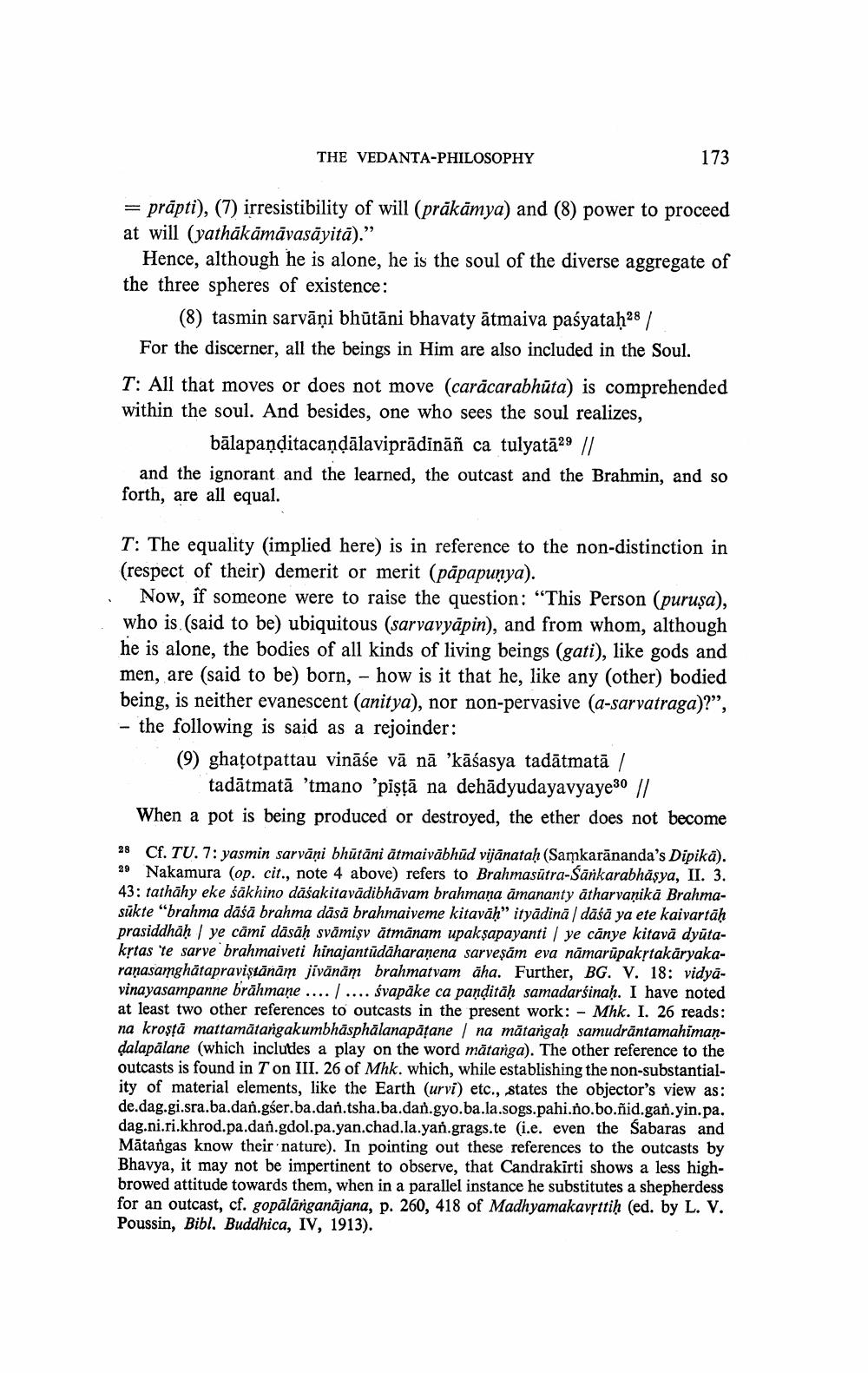Book Title: Vedanta Philosophy Described By Bhavya In His Madhyamaka Hrdaya Author(s): V V Gokhale Publisher: V V Gokhale View full book textPage 9
________________ THE VEDANTA-PHILOSOPHY 173 = prāpti), (7) irresistibility of will (prākāmya) and (8) power to proceed at will (yathākāmävasayitä)." Hence, although he is alone, he is the soul of the diverse aggregate of the three spheres of existence: (8) tasmin sarvāṇi bhūtāni bhavaty ātmaiva paśyataḥ28 / For the discerner, all the beings in Him are also included in the Soul. T: All that moves or does not move (carácarabhūta) is comprehended within the soul. And besides, one who sees the soul realizes, bālapaņditacaņdālaviprādināñ ca tulyatā29 // and the ignorant and the learned, the outcast and the Brahmin, and so forth, are all equal. T: The equality (implied here) is in reference to the non-distinction in (respect of their) demerit or merit (pāpapunya). : Now, if someone were to raise the question: "This Person (puruşa), who is (said to be) ubiquitous (sarvavyāpin), and from whom, although he is alone, the bodies of all kinds of living beings (gati), like gods and men, are (said to be) born, - how is it that he, like any (other) bodied being, is neither evanescent (anitya), nor non-pervasive (a-sarvatraga)?”, - the following is said as a rejoinder: (9) ghatotpattau vināśe vā nā 'kāśasya tadātmatā / tadātmatā 'tmano 'pistā na dehādyudayavyaye30 || When a pot is being produced or destroyed, the ether does not become 28 Cf. TU. 7: yasmin sarvāṇi bhūtāni ätmaivābhūd vijānatah (Samkarānanda's Dipikā). 29 Nakamura (op. cit., note 4 above) refers to Brahmasütra-Śārkarabhāşya, II. 3. 43: tathāhy eke śākhino dāśakitavādibhāvam brahmana amananty åtharvaniká Brahmasūkte "brahma dāśā brahma dāsā brahmaiveme kitavāḥ"ityādinā / dāśa ya ete kaivartāḥ prasiddhāh, ye cami dāsäh svämisv ātmānam upakşapayanti / ye canye kitavă dyutakrtas 'te sarve brahmaiveti hinajantūdāharaṇena sarveşām eva nămarūpakytakaryakaranasamghätapraviştānām jīvānām brahmatvam āha. Further, BG. V. 18: vidyavinayasampanne brāhmane ..../.... śvapāke ca paņditāḥ samadarsinah. I have noted at least two other references to outcasts in the present work: - Mhk. I. 26 reads: na krosta mattamătangakumbhāsphälanapāțane / na mātangaḥ samudrāntamahimandalapälane (which includes a play on the word mätarga). The other reference to the outcasts is found in Ton III. 26 of Mhk. which, while establishing the non-substantiality of material elements, like the Earth (urvi) etc., states the objector's view as: de.dag.gi.sra.ba.dan.gśer.ba.dan.tsha.ba.dan.gyo.ba.la.sogs.pahi.no.bo.ñid.gan.yin.pa. dag.ni.ri.khrod.pa.dan.gdol.pa.yan.chad.la.yan.grags.te (i.e. even the Sabaras and Mātangas know their nature). In pointing out these references to the outcasts by Bhavya, it may not be impertinent to observe, that Candrakirti shows a less highbrowed attitude towards them, when in a parallel instance he substitutes a shepherdess for an outcast, cf. gopālārganäjana, p. 260, 418 of Madhyamakavrttiḥ (ed. by L. V. Poussin, Bibl. Buddhica, IV, 1913).Page Navigation
1 ... 7 8 9 10 11 12 13 14 15 16
